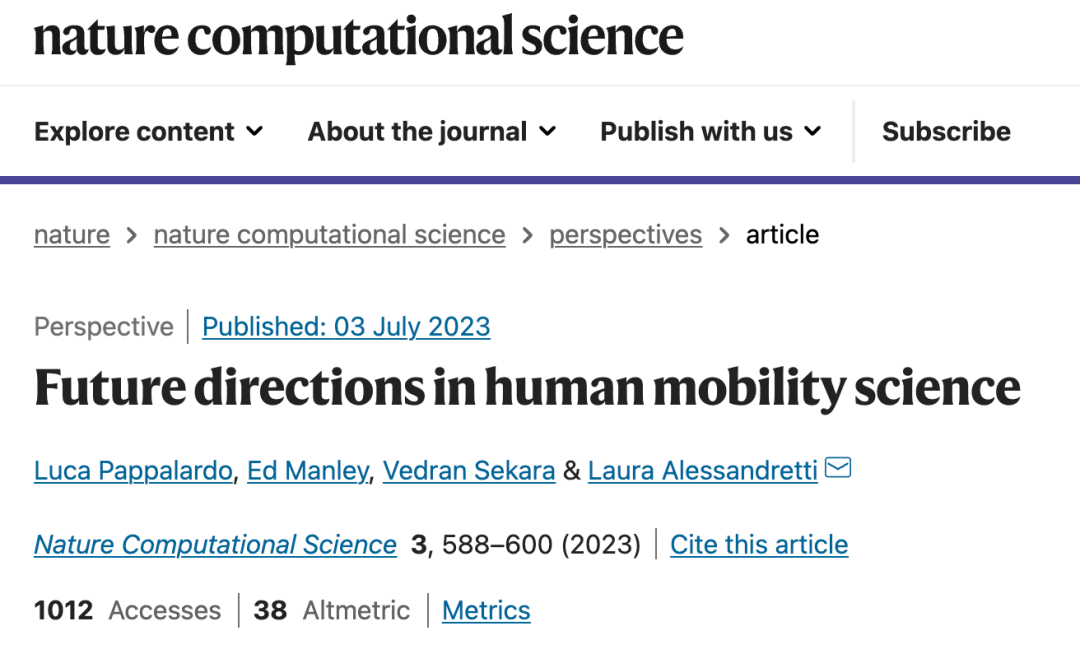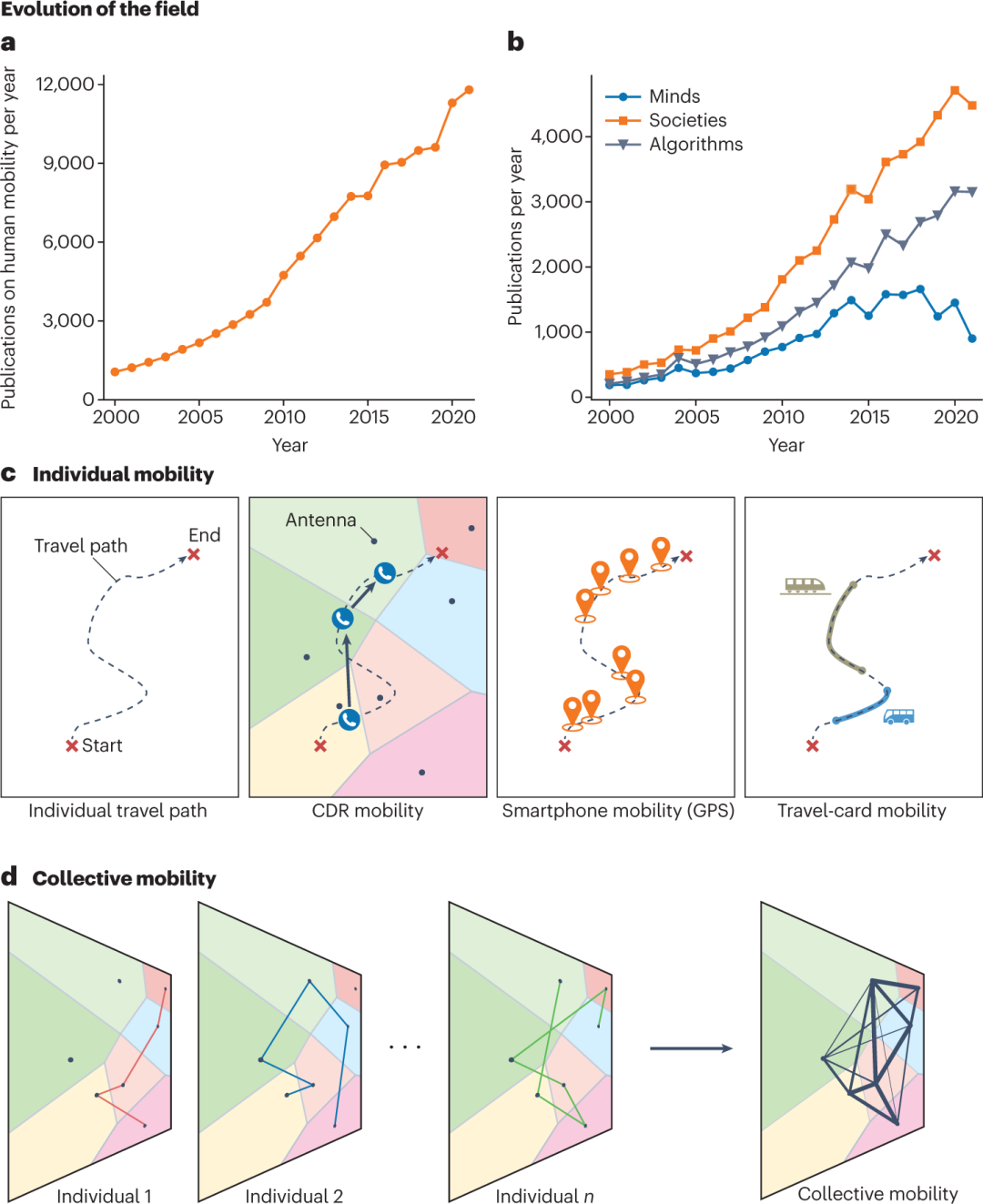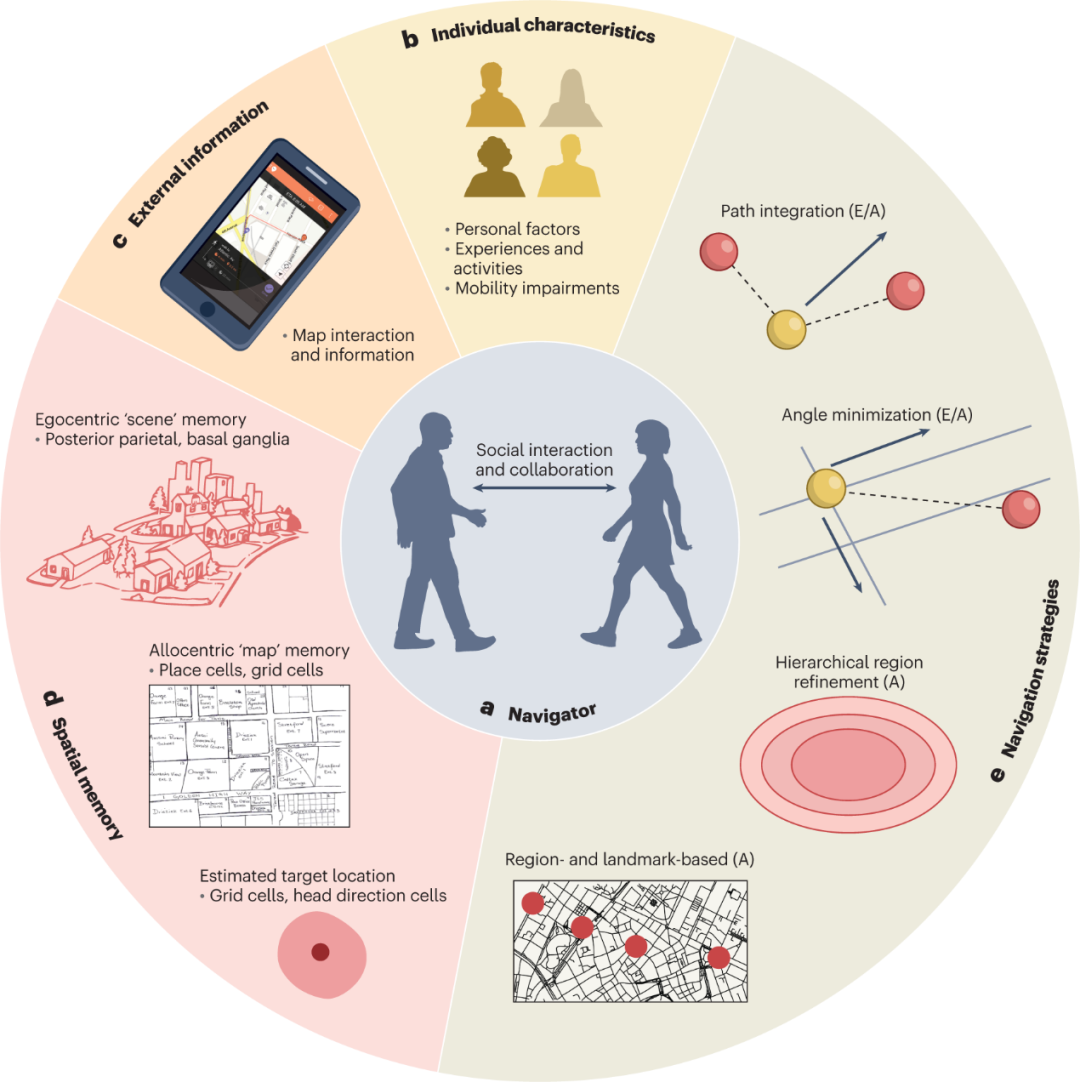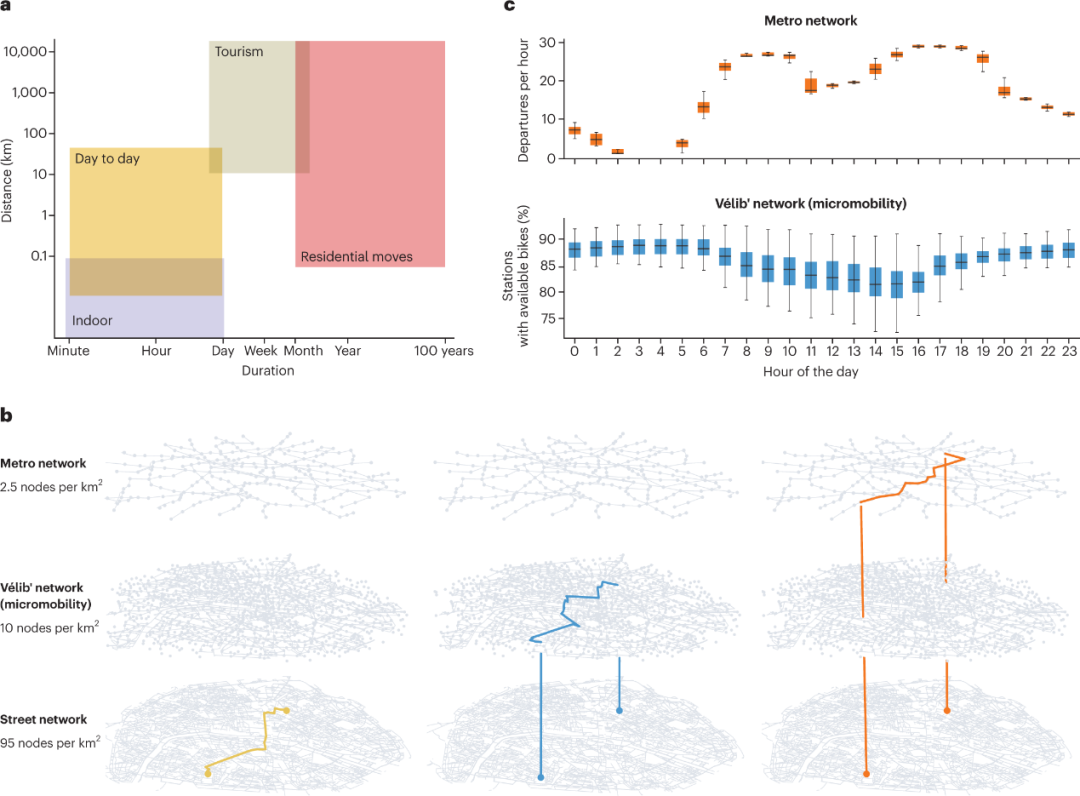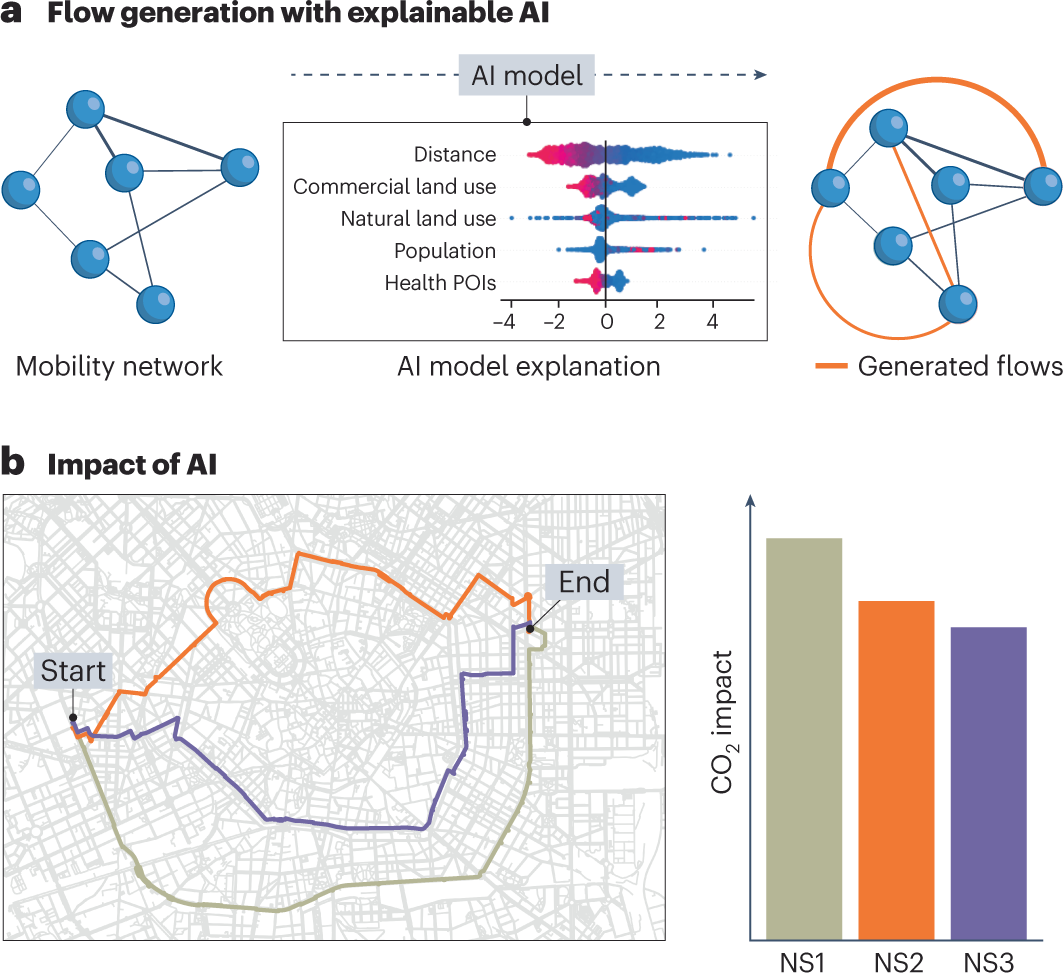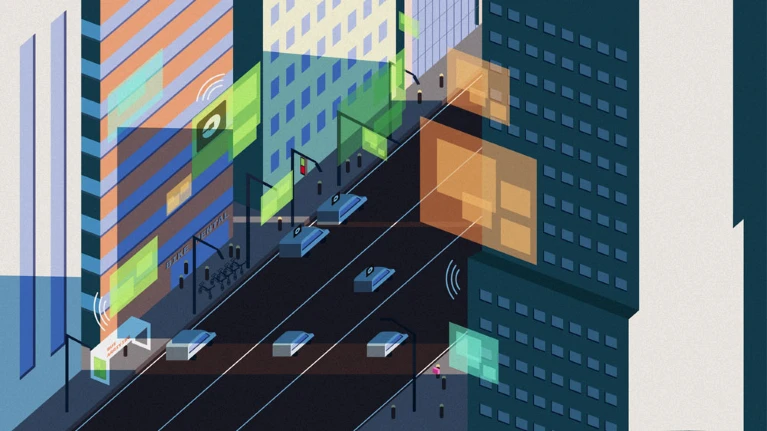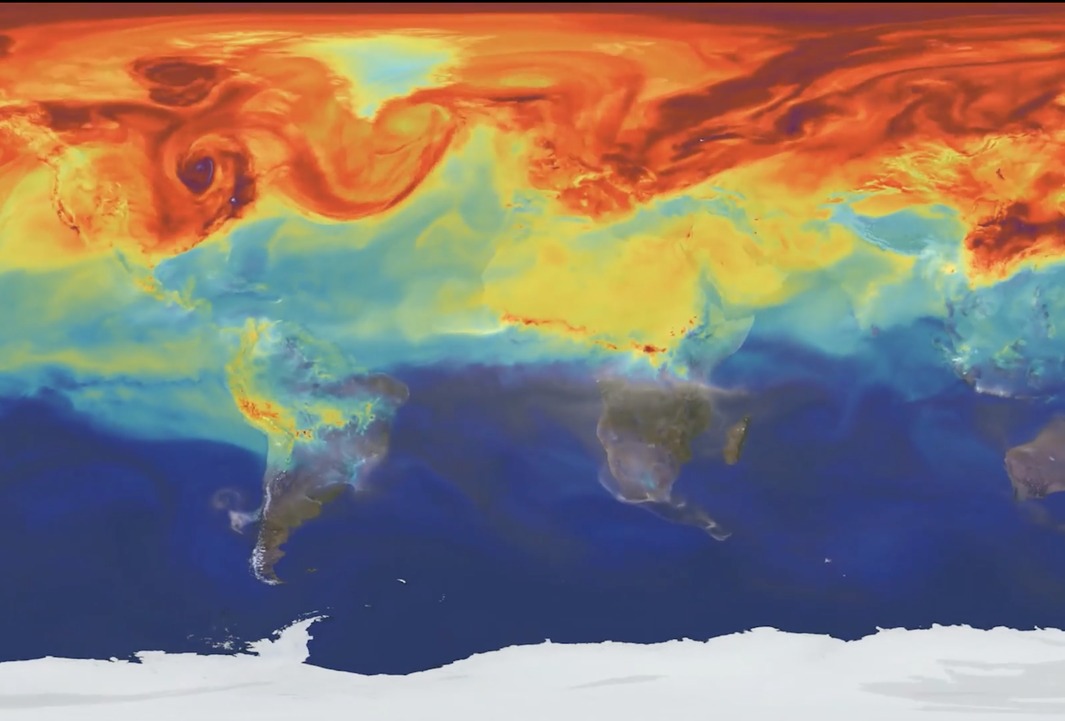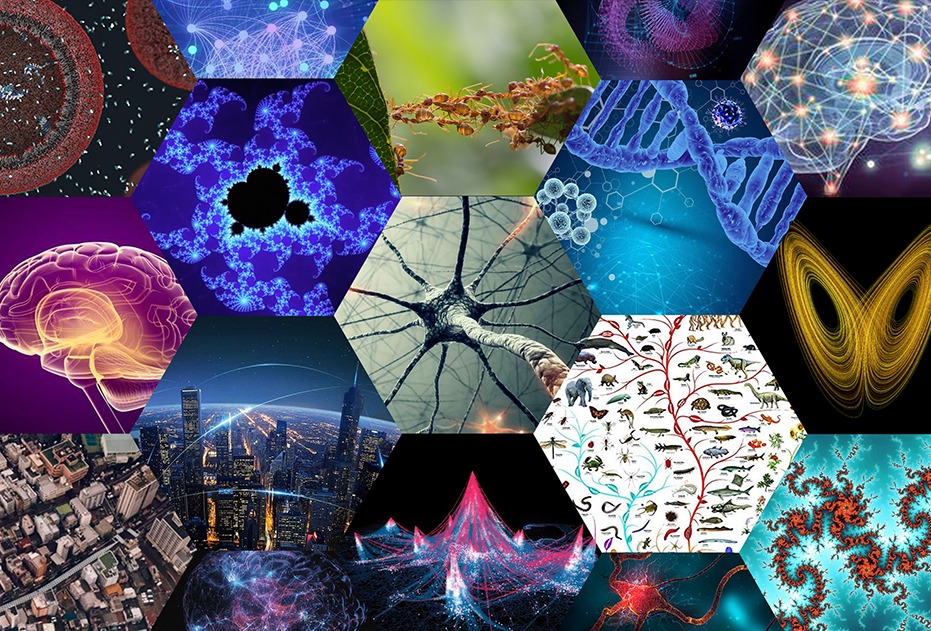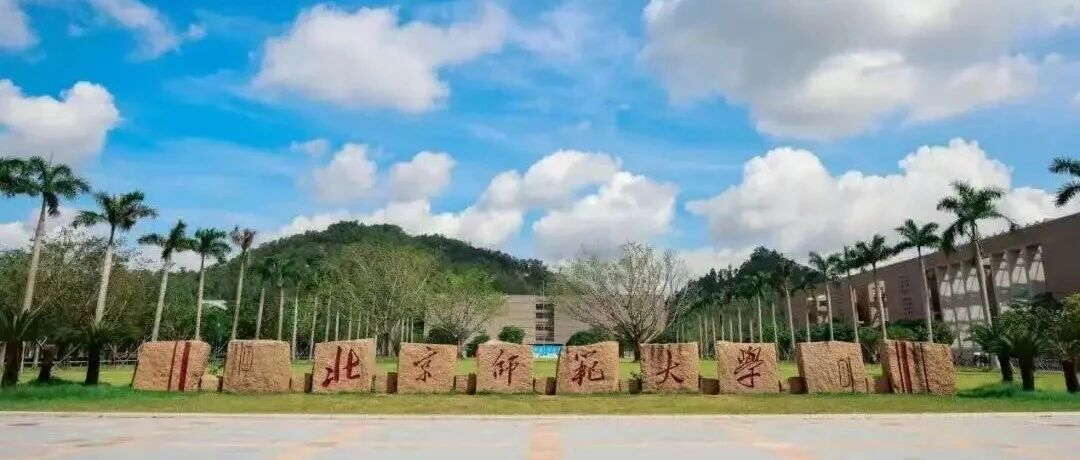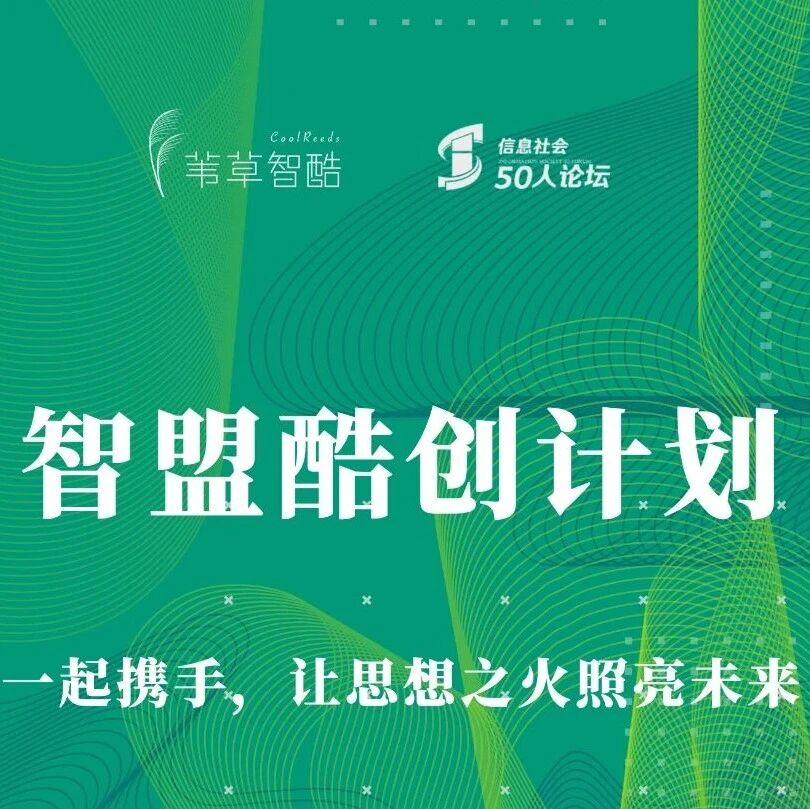-
Ravenstein, E. G. The laws of migration. J. R. Stat. Soc.52, 241–305 (1889).
-
Ravenstein, E. G. The Birthplaces of the People and the Laws of Migration (Trübner, 1876).
-
Barbosa, H. et al. Human mobility: models and applications. Phys. Rep.734, 1–74 (2018).
-
Wang, J., Kong, X., Xia, F. & Sun, L. Urban human mobility: data-driven modeling and prediction. SIGKDD Explor. Newsl.21, 1–19 (2019).
-
O’Dea, S. Smartphone users worldwide 2021 statista. Statistawww.statista.com/statistics/330695/number-of-smartphone-users-worldwide/ (2022).
-
Alessandretti, L., Aslak, U. & Lehmann, S. The scales of human mobility. Nature587, 402–407 (2020).
-
Barbosa, H., de Lima-Neto, F. B., Evsukoff, A. & Menezes, R. The effect of recency to human mobility. EPJ Data Sci.4, 1–14 (2015).
-
Bongiorno, C. et al. Vector-based pedestrian navigation in cities. Nat. Comput. Sci.1, 678–685 (2021).
-
Cornacchia, G. & Pappalardo, L. A mechanistic data-driven approach to synthesize human mobility considering the spatial, temporal, and social dimensions together. ISPRS Int. J. GeoInf.10, 599 (2021).
-
Pappalardo, L. et al. Returners and explorers dichotomy in human mobility. Nat. Commun.6, 8166 (2015).
-
Schläpfer, M. et al. The universal visitation law of human mobility. Nature593, 522–527 (2021).
-
Alessandretti, L., Sapiezynski, P., Lehmann, S. & Baronchelli, A. Multi-scale spatio-temporal analysis of human mobility. PLoS ONE12, 0171686 (2017).
-
Kraemer, M. U. et al. Mapping global variation in human mobility. Nat. Hum. Behav.4, 800–810 (2020).
-
Noulas, A., Scellato, S., Lambiotte, R., Pontil, M. & Mascolo, C. A tale of many cities: universal patterns in human urban mobility. PLoS ONE7, 37027 (2012).
-
Burbey, I. & Martin, T. L. A survey on predicting personal mobility. Int. J. Pervasive Comput. Commun.8, 5–22 (2012).
-
Calabrese, F., Di Lorenzo, G. & Ratti, C. Human mobility prediction based on individual and collective geographical preferences. In 13th International Conference on Intelligent Transportation Systems 312–317 (IEEE, 2010).
-
Dai, J., Yang, B., Guo, C. & Ding, Z. Personalized route recommendation using big trajectory data. In 31st International Conference on Data Engineering 543–554 (IEEE, 2015).
-
Luca, M., Barlacchi, G., Lepri, B. & Pappalardo, L. A survey on deep learning for human mobility. ACM Comput. Surv.55, 1–44 (2021).
-
Pappalardo, L. & Simini, F. Data-driven generation of spatio-temporal routines in human mobility. Data Min. Knowl. Discov.32, 787–829 (2018).
-
Simini, F., Barlacchi, G., Luca, M. & Pappalardo, L. A deep gravity model for mobility flows generation. Nat. Commun.12, 6576 (2021).
-
Zheng, Y. Trajectory data mining: an overview. ACM Trans. Intell. Syst. Technol.6, 1–41 (2015).
-
Zheng, Y., Capra, L., Wolfson, O. & Yang, H. Urban computing: concepts, methodologies, and applications. ACM Trans. Intell. Syst. Technol.5, 1–55 (2014).
-
Pappalardo, L., Ferres, L., Sacasa, M., Cattuto, C. & Bravo, L. Evaluation of home detection algorithms on mobile phone data using individual-level ground truth. EPJ Data Sci.10, 29 (2021).
-
Fudolig, M. I. D., Monsivais, D., Bhattacharya, K., Jo, H.-H. & Kaski, K. Internal migration and mobile communication patterns among pairs with strong ties. EPJ Data Sci.10, 16 (2021).
-
Moro, E., Calacci, D., Dong, X. & Pentland, A. Mobility patterns are associated with experienced income segregation in large US cities. Nat. Commun.12, 4633 (2021).
-
Pappalardo, L. et al. An analytical framework to nowcast well-being using mobile phone data. Int. J. Data Sci. Anal.2, 75–92 (2016).
-
Xue, H., Voutharoja, B. P. & Salim, F. D. Leveraging language foundation models for human mobility forecasting. In Proc. 30th International Conference on Advances in Geographic Information Systems Vol. 90, 1–9 (ACM, 2022).
-
Aleta, A. et al. Quantifying the importance and location of SARS-CoV-2 transmission events in large metropolitan areas. Proc. Natl Acad. Sci. USA119, 2112182119 (2022).
-
Lucchini, L. et al. Living in a pandemic: changes in mobility routines, social activity and adherence to COVID-19 protective measures. Sci. Rep.11, 24452 (2021).
-
Borst, H. C. et al. Influence of environmental street characteristics on walking route choice of elderly people. J. Environ. Psychol.29, 477–484 (2009).
-
Coutrot, A. et al. Entropy of city street networks linked to future spatial navigation ability. Nature604, 104–110 (2022).
-
Gauvin, L. et al. Gender gaps in urban mobility. Humanit. Soc. Sci. Commun.7, 11 (2020).
-
Macedo, M., Lotero, L., Cardillo, A., Menezes, R. & Barbosa, H. Differences in the spatial landscape of urban mobility: gender and socioeconomic perspectives. PLoS ONE17, 0260874 (2022).
-
Barbosa, H. et al. Uncovering the socioeconomic facets of human mobility. Sci. Rep.11, 8616 (2021).
-
Gonzalez, M. C., Hidalgo, C. A. & Barabasi, A.-L. Understanding individual human mobility patterns. Nature453, 779–782 (2008).
-
Gallotti, R., Bazzani, A., Rambaldi, S. & Barthelemy, M. A stochastic model of randomly accelerated walkers for human mobility. Nat. Commun.7, 12600 (2016).
-
Pappalardo, L., Rinzivillo, S., Qu, Z., Pedreschi, D. & Giannotti, F. Understanding the patterns of car travel. Eur. Phys. J. Spec. Top.215, 61–73 (2013).
-
Song, C., Qu, Z., Blumm, N. & Barabási, A.-L. Limits of predictability in human mobility. Science327, 1018–1021 (2010).
-
Scherrer, L., Tomko, M., Ranacher, P. & Weibel, R. Travelers or locals? Identifying meaningful sub-populations from human movement data in the absence of ground truth. EPJ Data Sci.7, 1–21 (2018).
-
Alessandretti, L., Sapiezynski, P., Sekara, V., Lehmann, S. & Baronchelli, A. Evidence for a conserved quantity in human mobility. Nat. Hum. Behav.2, 485–491 (2018).
-
Barbosa, H., de Lima-Neto, F. B., Evsukoff, A. & Menezes, R. The effect of recency to human mobility. EPJ Data Sci.4, 1–14 (2015).
-
Song, C., Koren, T., Wang, P. & Barabási, A.-L. Modelling the scaling properties of human mobility. Nat. Phys.6, 818–823 (2010).
-
Lu, X., Wetter, E., Bharti, N., Tatem, A. J. & Bengtsson, L. Approaching the limit of predictability in human mobility. Sci. Rep.3, 2923 (2013).
-
Smith, G., Wieser, R., Goulding, J. & Barrack, D. A refined limit on the predictability of human mobility. In International Conference on Pervasive Computing and Communications 88–94 (IEEE, 2014).
-
Cuttone, A., Lehmann, S. & González, M. C. Understanding predictability and exploration in human mobility. EPJ Data Sci.7, 1–17 (2018).
-
Ikanovic, E. L. & Mollgaard, A. An alternative approach to the limits of predictability in human mobility. EPJ Data Sci.6, 1–10 (2017).
-
Schneider, C. M., Belik, V., Couronné, T., Smoreda, Z. & González, M. C. Unravelling daily human mobility motifs. J. R. Soc. Interface10, 20130246 (2013).
-
Yan, X.-Y., Wang, W.-X., Gao, Z.-Y. & Lai, Y.-C. Universal model of individual and population mobility on diverse spatial scales. Nat. Commun.8, 1639 (2017).
-
Simini, F., González, M. C., Maritan, A. & Barabási, A.-L. A universal model for mobility and migration patterns. Nature484, 96–100 (2012).
-
Tversky, B. Cognitive maps, cognitive collages, and spatial mental models. In European Conference on Spatial Information Theory 14–24 (Springer, 1993).
-
Sadalla, E. K., Burroughs, J. W. & Staplin, L. J. Reference points in spatial cognition. J. Exp. Psychol. Hum. Learn. Mem.6, 516–528 (1980).
-
Weisberg, S. M. & Newcombe, N. S. How do (some) people make a cognitive map? Routes, places, and working memory. J. Exp. Psychol. Learn. Mem. Cogn.42, 768 (2016).
-
Newcombe, N. & Liben, L. S. Barrier effects in the cognitive maps of children and adults. J. Exp. Child Psychol.34, 46–58 (1982).
-
Moser, E. I., Kropff, E. & Moser, M.-B. et al. Place cells, grid cells, and the brain’s spatial representation system. Annu. Rev. Neurosci.31, 69–89 (2008).
-
Hirtle, S. C. & Jonides, J. Evidence of hierarchies in cognitive maps. Mem. Cogn.13, 208–217 (1985).
-
Balaguer, J., Spiers, H., Hassabis, D. & Summerfield, C. Neural mechanisms of hierarchical planning in a virtual subway network. Neuron90, 893–903 (2016).
-
Lynch, K. The Image of the City Vol. 1 (MIT Press, 1960).
-
Filomena, G., Verstegen, J. A. & Manley, E. A computational approach to ‘The Image of the City’. Cities89, 14–25 (2019).
-
Winter, S., Tomko, M., Elias, B. & Sester, M. Landmark hierarchies in context. Environ. Plann. B35, 381–398 (2008).
-
Kuipers, B. Modeling spatial knowledge. Cogn. Sci.2, 129–153 (1978).
-
Chown, E., Kaplan, S. & Kortenkamp, D. Prototypes, location, and associative networks (PLAN): towards a unified theory of cognitive mapping. Cogn. Sci.19, 1–51 (1995).
-
Manley, E., Filomena, G. & Mavros, P. A spatial model of cognitive distance in cities. Int. J. Geogr. Inf. Sci.35, 2316–2338 (2021).
-
Ben-Akiva, M., Bergman, M., Daly, A. J. & Ramaswamy, R. Modelling inter urban route choice behaviour. In Papers Presented During the Ninth International Symposium on Transportation and Traffic Theory 299–330 (VNU Science Press, 1984).
-
Manley, E. J., Addison, J. D. & Cheng, T. Shortest path or anchor-based route choice: a large-scale empirical analysis of minicab routing in London. J. Transp. Geogr.43, 123–139 (2015).
-
Malleson, N. et al. The characteristics of asymmetric pedestrian behavior: a preliminary study using passive smartphone location data. Trans. GIS22, 616–634 (2018).
-
Lima, A., Stanojevic, R., Papagiannaki, D., Rodriguez, P. & González, M. C. Understanding individual routing behaviour. J. R. Soc. Interface13, 20160021 (2016).
-
Sevtsuk, A. & Basu, R. The role of turns in pedestrian route choice: a clarification. J. Transp. Geogr.102, 103392 (2022).
-
Miranda, A. S., Fan, Z., Duarte, F. & Ratti, C. Desirable streets: using deviations in pedestrian trajectories to measure the value of the built environment. Comput. Environ. Urban Syst.86, 101563 (2021).
-
Guo, Z. & Loo, B. P. Pedestrian environment and route choice: evidence from New York City And Hong Kong. J. Transp. Geogr.28, 124–136 (2013).
-
Gilbert, N. et al. (eds) Tools and Techniques for Social Science Simulation 83–114 (Springer, 2000).
-
Georgeff, M., Pell, B., Pollack, M., Tambe, M. & Wooldridge, M. The belief-desire-intention model of agency. In Proc. Intelligent Agents V: Agents Theories, Architectures, and Languages: 5th International Workshop 1–10 (Springer, 1999).
-
Manley, E., Orr, S. W. & Cheng, T. A heuristic model of bounded route choice in urban areas. Transp. Res. Part C56, 195–209 (2015).
-
Aboutaleb, Y. M., Danaf, M., Xie, Y. & Ben-Akiva, M. Discrete choice analysis with machine learning capabilities. Preprint at https://arxiv.org/abs/2101.10261 (2021).
-
Banino, A. et al. Vector-based navigation using grid-like representations in artificial agents. Nature557, 429–433 (2018).
-
Mirowski, P. et al. Learning to navigate in cities without a map. In Advances in Neural Information Processing Systems Vol. 31, 2424–2435 (Curran Associates, 2018).
-
Hancock, T. O. & Choudhury, C. F. Utilising physiological data for augmenting travel choice models: methodological frameworks and directions of future research. Transp. Rev.https://doi.org/10.1080/01441647.2023.2175274 (2023).
-
Qin, T., Dong, W. & Huang, H. Perceptions of space and time of public transport travel associated with human brain activities: a case study of bus travel in Beijing. Comput. Environ. Urban Syst.99, 101919 (2023).
-
Coutrot, A. et al. Global determinants of navigation ability. Curr. Biol.28, 2861–28664 (2018).
-
Montello, D. R. in Spatial and Temporal Reasoning in Geographic Information Systems 143–154 (Oxford Univ. Press, 1998).
-
Mavros, P. et al. Collaborative wayfinding under distributed spatial knowledge. In 15th International Conference on Spatial Information Theory: Leibniz International Proceedings in Informatics Vol. 240 (eds Ishikawa, T. et al.) 25:1–25:10 (Schloss Dagstuhl, Leibniz-Zentrum für Informatik, 2022).
-
Spiers, H. J. & Maguire, E. A. The dynamic nature of cognition during wayfinding. J. Environ. Psychol.28, 232–249 (2008).
-
Ishikawa, T., Fujiwara, H., Imai, O. & Okabe, A. Wayfinding with a GPS-based mobile navigation system: a comparison with maps and direct experience. J. Environ. Psychol.28, 74–82 (2008).
-
Gardony, A. L., Brunyé, T. T., Mahoney, C. R. & Taylor, H. A. How navigational aids impair spatial memory: evidence for divided attention. Spat. Cogn. Comput.13, 319–350 (2013).
-
Alessandretti, L., Natera Orozco, L. G., Battiston, F., Saberi, M. & Szell, M. Multimodal urban mobility and multilayer transport networks. Environ. Plann. B.https://doi.org/10.1177/23998083221108190 (2022).
-
Mohamed, K., Côme, E., Oukhellou, L. & Verleysen, M. Clustering smart card data for urban mobility analysis. IEEE Trans. Intell.Transp. Syst.18, 712–728 (2016).
-
Zhong, C., Manley, E., Arisona, S. M., Batty, M. & Schmitt, G. Measuring variability of mobility patterns from multiday smart-card data. J. Comput. Sci.9, 125–130 (2015).
-
Zhong, C. et al. Variability in regularity: mining temporal mobility patterns in London, Singapore and Beijing using smart-card data. PLoS ONE11, 0149222 (2016).
-
Nations, U. World Urbanization Prospects (United Nations, 2014)
-
Pelaez Bueno, A. Identifying and Quantifying Mobility Hubs MSc thesis. ETH Zurich (2021).
-
Wirtz, M. H. & Klähr, J. Smartphone based in/out ticketing systems: a new generation of ticketing in public transport and its performance testing. WIT Trans. Built Environ.182, 351–359 (2019).
-
Baldauf, M. & Tomitsch, M. Pervasive displays for public transport: an overview of ubiquitous interactive passenger services. In Proc. 9th ACM International Symposium on Pervasive Displays 37–45 (Association for Computing Machinery, 2020).
-
Nahmias-Biran, B.-h et al. Enriching activity-based models using smartphone-based travel surveys. Transp. Res. Rec.2672, 280–291 (2018).
-
Amini, A., Kung, K., Kang, C., Sobolevsky, S. & Ratti, C. The impact of social segregation on human mobility in developing and industrialized regions. EPJ Data Sci.3, 1–20 (2014).
-
Crawford, F. W. et al. Impact of close interpersonal contact on COVID-19 incidence: evidence from 1 year of mobile device data. Sci. Adv.8, 5499 (2022).
-
Machado, C. A. S., de Salles Hue, N. P. M., Berssaneti, F. T. & Quintanilha, J. A. An overview of shared mobility. Sustainability10, 4342 (2018).
-
McNally, M. G. in Handbook of Transport Modelling (Emerald Group, 2007).
-
Axhausen, K. W., Horni, A. & Nagel, K. The Multi-agent Transport Simulation MATSim (Ubiquity Press, 2016).
-
Lu, N., Cheng, N., Zhang, N., Shen, X. & Mark, J. W. Connected vehicles: solutions and challenges. IEEE Internet Things J.1, 289–299 (2014).
-
Ward, J. A., Evans, A. J. & Malleson, N. S. Dynamic calibration of agent-based models using data assimilation. R. Soc. Open Sci.3, 150703 (2016).
-
Morandi, V. Bridging the user equilibrium and the system optimum in static traffic assignment: a review. 4ORhttps://doi.org/10.1007/s10288-023-00540-w (2023).
-
Sejnowski, T. J. The Deep Learning Revolution (MIT Press, 2018).
-
LeCun, Y., Bengio, Y. & Hinton, G. Deep learning. Nature521, 436–444 (2015).
-
Silver, D. et al. Mastering the game of Go with deep neural networks and tree search. Nature529, 484–489 (2016).
-
Titano, J. J. et al. Automated deep-neural-network surveillance of cranial images for acute neurologic events. Nat. Med.24, 1337–1341 (2018).
-
Krizhevsky, A., Sutskever, I. & Hinton, G. E. ImageNet classification with deep convolutional neural networks. Commun. ACM60, 84–90 (2017).
-
Wu, Y. et al. Google’s neural machine translation system: bridging the gap between human and machine translation. Preprint at https://arxiv.org/abs/1609.08144 (2016).
-
Zheng, X., Han, J. & Sun, A. A survey of location prediction on Twitter. IEEE Trans. Knowl. Data Eng.30, 1652–1671 (2018).
-
Rumbert, D. E. Learning internal representations by error propagation. Parallel Distrib. Process.1, 318–363 (1986).
-
Jiang, S. et al. The TimeGeo modeling framework for urban mobility without travel surveys. Proc. Natl Acad. Sci. USA113, 5370–5378 (2016).
-
Toole, J. L., Herrera-Yaqüe, C., Schneider, C. M. & González, M. C. Coupling human mobility and social ties. J. R. Soc. Interface12, 20141128 (2015).
-
Zipf, G. K. The P1P2/D hypothesis: on the intercity movement of persons. Am. Sociol. Rev.11, 677–686 (1946).
-
Liu, E.-J. & Yan, X.-Y. A universal opportunity model for human mobility. Sci. Rep.10, 4657 (2020).
-
Goodfellow, I. et al. Generative adversarial nets. In Advances in Neural Information Processing Systems 27 (NIPS, 2014)
-
Kingma, D. P. & Welling, M. Auto-encoding variational Bayes. Preprint at https://arxiv.org/abs/1312.6114 (2013).
-
Mauro, G., Luca, M., Longa, A., Lepri, B. & Pappalardo, L. Generating mobility networks with generative adversarial networks. EPJ Data Sci.11, 58 (2022).
-
Bao, H., Zhou, X., Xie, Y., Zhang, Y. & Li, Y. COVID-GAN+: estimating human mobility responses to COVID-19 through spatio-temporal generative adversarial networks with enhanced features. ACM Trans. Intell. Syst. Technol.https://doi.org/10.1145/3481617 (2022).
-
Feng, J. et al. Learning to simulate human mobility. In Proc. 26th ACM SIGKDD International Conference on Knowledge Discovery and Data Mining 3426–3433 (ACM, 2020)
-
Huang, D. et al. A variational autoencoder based generative model of urban human mobility. In Conference on Multimedia Information Processing and Retrieval 425–430 (IEEE, 2019).
-
Ouyang, K., Shokri, R., Rosenblum, D. S. & Yang, W. A non-parametric generative model for human trajectories. In Proc. Twenty-Seventh International Joint Conference on Artificial Intelligence Vol. 18, 3812–3817 (AAAI, 2018).
-
Amatriain, X. Transformer models: an introduction and catalog. Preprint at https://arxiv.org/abs/2302.07730 (2023).
-
Mizuno, T., Fujimoto, S. & Ishikawa, A. Generation of individual daily trajectories by GPT-2. Front. Phys.10, 1118 (2022).
-
Ma, J. et al. Human trajectory completion with transformers. In International Conference on Communications 3346–3351 (IEEE, 2022).
-
Guidotti, R. et al. A survey of methods for explaining black box models. ACM Comput. Surv.51, 1–42 (2018).
-
Naretto, F., Pellungrini, R., Monreale, A., Nardini, F. M. & Musolesi, M. in Discovery Science. DS 2020. Lecture Notes in Computer Science Vol. 12323 (eds Appice, A. et al.) 403–418 (Springer, 2020).
-
Huang, X. & Marques-Silva, J. The inadequacy of shapley values for explainability. Preprint at https://arxiv.org/abs/2302.08160 (2023).
-
Kumar, I. E., Venkatasubramanian, S., Scheidegger, C. & Friedler, S. Problems with shapley-value-based explanations as feature importance measures. In International Conference on Machine Learning 5491–5500 (PMLR. 2020).
-
Jonietz, D. et al. Urban mobility analytics: report from Dagstuhl seminar 22162. Dagstuhl Rep.12, 26–53 (2022).
-
Rolnick, D. et al. Tackling climate change with machine learning. ACM Comput. Surv.55, 1–96 (2022).
-
Bai, X. et al. Six research priorities for cities and climate change. Nature555, 23–25 (2018).
-
Voukelatou, V. et al. Measuring objective and subjective well-being: dimensions and data sources. Int. J. Data Sci. Anal.11, 279–309 (2021).
-
Yan, A. & Howe, B. Fairness-aware demand prediction for new mobility. In Proc. AAAI Conference on Artificial Intelligence Vol. 34, 1079–1087 (AAAI, 2020).
-
Yan, A. & Howe, B. FairST: equitable spatial and temporal demand prediction for new mobility systems. In Proc. 27th International Conference on Advances in Geographic Information Systems 552–555 (ACM, 2019).
-
Yan, A. & Howe, B. Fairness in practice: a survey on equity in urban mobility. Q. Bull. Comput. Soc. IEEE42, 49–63 (2019).
-
Ngo, N. S., Götschi, T. & Clark, B. Y. The effects of ride-hailing services on bus ridership in a medium-sized urban area using micro-level data: evidence from the Lane Transit District. Transp. Policy105, 44–53 (2021).
-
Ge, Y., Knittel, C. R., MacKenzie, D. & Zoepf, S. Racial and Gender Discrimination in Transportation Network Companies Technical Report (National Bureau of Economic Research, 2016).
-
Arora, N. et al. Quantifying the sustainability impact of Google Maps: a case study of Salt Lake City. Preprint at https://arxiv.org/abs/2111.03426 (2021).
-
Perez-Prada, F., Monzon, A. & Valdes, C. Managing traffic flows for cleaner cities: the role of green navigation systems. Energies10, 791 (2017).
-
Mehrvarz, N., Ye, Z., Barati, K. & Shen, X. Optimal Travel Routes of On-road Vehicles Considering Sustainability (IAARC Publications, 2020).
-
Cornacchia, G. et al. How routing strategies impact urban emissions. In Proc. 30th International Conference on Advances in Geographic Information Systemshttps://doi.org/10.1145/3557915.3560977 (ACM, 2022).
-
Lai, S. et al. Effect of non-pharmaceutical interventions to contain COVID-19 in China. Nature585, 410–413 (2020).
-
Haushofer, J. & Metcalf, C. J. E. Which interventions work best in a pandemic? Science368, 1063–1065 (2020).
-
Gao, S. et al. Mobile phone location data reveal the effect and geographic variation of social distancing on the spread of the COVID-19 epidemic. Preprint at https://arxiv.org/abs/2004.11430 (2020).
-
Chinazzi, M. et al. The effect of travel restrictions on the spread of the 2019 novel coronavirus (COVID-19) outbreak. Science368, 395–400 (2020).
-
Gatto, M. et al. Spread and dynamics of the COVID-19 epidemic in Italy: effects of emergency containment measures. Proc. Natl Acad. Sci. USA117, 10484–10491 (2020).
-
Jia, J. S. et al. Population flow drives spatio-temporal distribution of COVID-19 in China. Nature582, 389–394 (2020).
-
Tian, H. et al. An investigation of transmission control measures during the first 50 days of the COVID-19 epidemic in China. Science368, 638–642 (2020).
-
Ross, S., Breckenridge, G., Zhuang, M. & Manley, E. Household visitation during the COVID-19 pandemic. Sci. Rep.11, 22871 (2021).
-
Pappalardo, L., Cornacchia, G., Navarro, V., Bravo, L. & Ferres, L. A dataset to assess mobility changes in Chile following local quarantines. Sci. Data10, 6 (2023).
-
Ritchie, H. Sector by sector: where do global greenhouse gas emissions come from? Our World in Datahttps://ourworldindata.org/ghg-emissions-by-sector (2020).
-
Transforming Our World: the 2030 Agenda for Sustainable Development Technical Report (United Nations General Assembly, 2015).
-
Böhm, M., Nanni, M. & Pappalardo, L. Gross polluters and vehicle emissions reduction. Nat. Sustain.https://doi.org/10.1038/s41893-022-00903-x (2022).
-
Nyhan, M. et al. Predicting vehicular emissions in high spatial resolution using pervasively measured transportation data and microscopic emissions model. Atmos. Environ.140, 352–363 (2016).
-
Macfarlane, J. When apps rule the road: the proliferation of navigation apps is causing traffic chaos. It’s time to restore order. IEEE Spectrum56, 22–27 (2019).
-
Lu, Y., Nakicenovic, N., Visbeck, M. & Stevance, A.-S. Policy: Five priorities for the unsustainable development goals. Nature520, 432–433 (2015).
-
Glaeser, E. L., Resseger, M. & Tobio, K. Inequality in cities. J. Reg. Sci.49, 617–646 (2009).
-
Sanchez, T. W., Stolz, R. & Ma, J. S. Inequitable effects of transportation policies on minorities. Transp. Res. Rec.1885, 104–110 (2004).
-
Smith, D. A. & Barros, J. in Urban Form and Accessibility (Mulley, C. & Nelson, J. D.) 27–44 (Elsevier, 2021).
-
Carpio-Pinedo, J. Multimodal transport and potential encounters with social difference: a novel approach based on network analysis. J. Urban Aff.43, 93–116 (2021).
-
Gillies, S. et al. Shapely: manipulation and analysis of geometric objects. GitHubhttps://github.com/Toblerity/Shapely (2007).
-
Sekara, V. et al. in Guide to Mobile Data Analytics in Refugee Scenarios 53–66 (2019).
-
Schlosser, F., Sekara, V., Brockmann, D. & Garcia-Herranz, M. Biases in human mobility data impact epidemic modeling. Preprint at https://arxiv.org/abs/2112.12521 (2021).
-
Zhao, Z. et al. Understanding the bias of call detail records in human mobility research. Int. J. Geogr. Inf. Sci.30, 1738–1762 (2016).
-
Blumenstock, J. & Eagle, N. Mobile divides: gender, socioeconomic status, and mobile phone use in Rwanda. In Proc. 4th ACM/IEEE International Conference on Information and Communication Technologies and Development 1–10 (ACM/IEEE, 2010)
-
Wesolowski, A., Eagle, N., Noor, A. M., Snow, R. W. & Buckee, C. O. Heterogeneous mobile phone ownership and usage patterns in kenya. PLoS ONE7, 35319 (2012).
-
Wesolowski, A., Eagle, N., Noor, A. M., Snow, R. W. & Buckee, C. O. The impact of biases in mobile phone ownership on estimates of human mobility. J. R. Soc. Interface10, 20120986 (2013).
-
I.T.U.: World Telecommunication/ICT Indicators Database (ITU, 2022).
-
Leo, Y., Fleury, E., Alvarez-Hamelin, J. I., Sarraute, C. & Karsai, M. Socioeconomic correlations and stratification in social-communication networks. J. R. Soc. Interface13, 20160598 (2016).
-
Ricciato, F. et al. Estimating Population Density Distribution from Network-based Mobile Phone Data (Publications Office of the European Union, 2015).
-
Acosta, R. J., Kishore, N., Irizarry, R. A. & Buckee, C. O. Quantifying the dynamics of migration after Hurricane Maria in Puerto Rico. Proc. Natl Acad. Sci. USA117, 32772–32778 (2020).
-
Salganik, M. J. Bit by Bit: Social Research in the Digital Age (Princeton Univ. Press, 2019).
-
Tizzoni, M. et al. On the use of human mobility proxies for modeling epidemics. PLoS Comput. Biol.10, 1003716 (2014).
-
Pestre, G., Letouzé, E. & Zagheni, E. The ABCDE of big data: assessing biases in call-detail records for development estimates. World Bank Econ. Rev.34, 89–97 (2020).
-
Blondel, V. D., Decuyper, A. & Krings, G. A survey of results on mobile phone datasets analysis. EPJ Data Sci.4, 10 (2015).
-
De Montjoye, Y.-A. et al. On the privacy-conscientious use of mobile phone data. Sci. Data5, 180286 (2018).
-
Rzeszewski, M. & Luczys, P. Care, indifference and anxiety-attitudes toward location data in everyday life. ISPRS Int. J. GeoInf.7, 383 (2018).
-
Gerber, N., Gerber, P. & Volkamer, M. Explaining the privacy paradox: a systematic review of literature investigating privacy attitude and behavior. Comput. Secur.77, 226–261 (2018).
-
Taylor, L. No place to hide? The ethics and analytics of tracking mobility using mobile phone data. Environ. Plann. D34, 319–336 (2016).
-
Maxmen, A. Surveillance science. Nature569, 614–617 (2019).
-
Stadler, J. et al. Cognitive mapping: using local knowledge for planning health research. BMC Med. Res. Methodol.13, 96 (2013).


